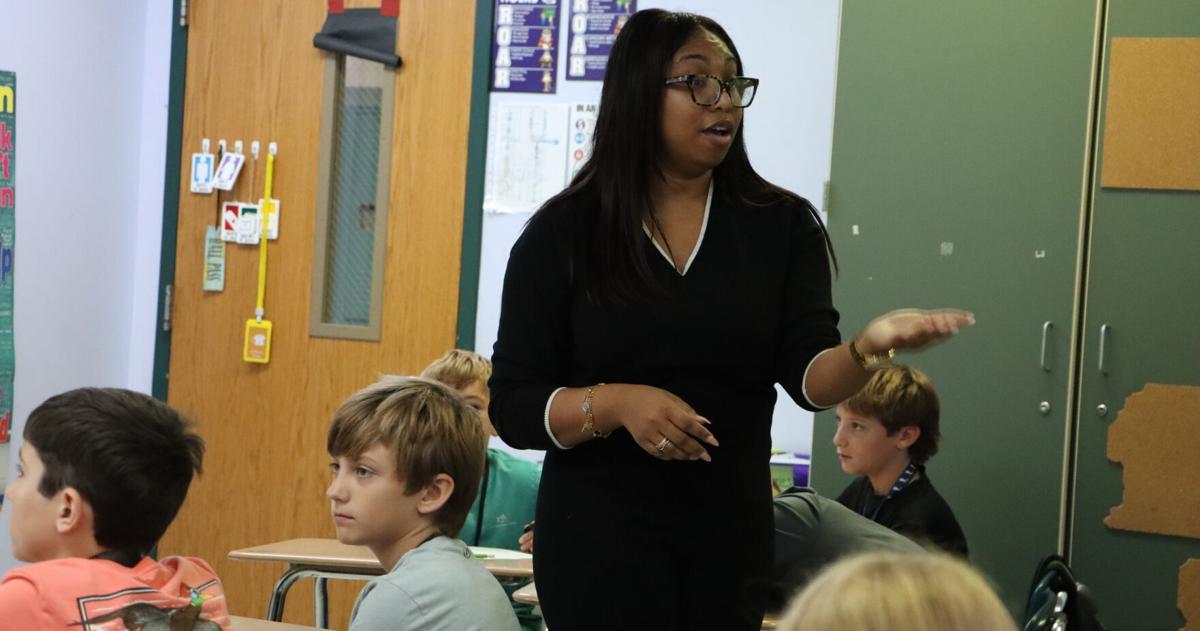Technology
Just not good at math? Not for long, SC school leaders say amid push in the subject.
SALUDA — South Carolina’s education leaders have a simple message for their state:
“Every student is a math student.”
They’re tired of the idea that some kids just aren’t good at math, or that it’s alright to excuse mediocrity in the subject as a symptom of a preference for reading or history.
And they’re hoping they can move the needle with a support initiative that went into full effect this school year, combining new standards with tutoring and classroom support for teachers and students at struggling schools.
The effort is focused on middle schools, where South Carolina students are performing worse than their peers in younger grades and other middle schoolers in the rest of the country.
Some grades are still scoring worse on state testing than they did before the COVID-19 pandemic, while English scores have surpassed those COVID levels. Last year, 34 percent of seventh graders passed the math SC Ready test compared to about 58 percent passing the English one.
“We know, especially in middle school, our data is nowhere near where it needs to be,” said Abbey Duggins, deputy superintendent and chief academic office at the S.C. Department of Education.
The Palmetto Math Project
Saluda Middle School is one of the 64 campuses across the state getting the highest level of support from the state’s math push, called the Palmetto Math Project.
Each of those schools, the most vulnerable in the state, is assigned a state math specialist who once a week co-teaches lessons with the school’s math teachers and coaches them on instructional strategies and lesson planning.
Their presence is meant to help students, but they are especially focused on developing teachers’ skillsets. Specialists debrief with teachers after each lesson, going through what worked and what could be improved.
For Jax Sanchez, a sixth-grade teacher at Saluda Middle, having specialist Lauren Cantey in his classroom every Wednesday is “kind of a second brain for me.”
The second-year teacher had trouble with his lesson sequencing — the way teachers map out their classes for students to understand each concept. Cantey has helped him improve that process and find better instructional resources as they plan lessons together, Sanchez said.
“It gives me more time to focus on what my students are doing in class so I can look back on work that they’re doing, and (spend) less time planning on doing class,” he said.
Schools like Saluda Middle get a lot of state support; teachers in about 85 other schools making up a better-performing second tier get regional support, including training on new standards and materials.
The extra support comes in handy because the state expects some instructors to adjust how they teach math. New instructional materials going into classrooms use what’s called a concrete-representational-abstract approach, which is out of some teachers’ comfort zones, said Elizabeth Schumpert, the team lead for the Palmetto Math Project.
The idea of that approach is for students to better understand the “why” behind the math, rather than just learning rules, tips or tricks.
A middle schooler learning how to multiply a whole number by a decimal, for example, can’t rely on the rule they learned in third grade that says the product of a multiplication problem is larger than the initial two numbers — they have to understand that with a decimal, the product will be smaller than the initial whole number, and why that’s the case.
“Too often, we just teach it, and we do it, and we move on,” Schumpert said. “We don’t go through the why.”
Part of helping students build that deeper knowledge is starting with a concrete understanding of an abstract math concept, sometimes by using tools like dice, blocks or chips to give a physical reference. Educators call those tools “manipulatives,” and their absence in virtual learning is one reason why experts think math performance plummeted so much during the pandemic.
Earlier in the year in Sanchez’ class, for instance, students used blocks to represent exponents. They help better engage the students, giving them something to do with their hands rather than just a worksheet, Sanchez said.
Students can progress from the concrete to the representational, where they use a pictorial representation of that process, and finally the fully abstract version using numbers and algebraic notation.
It’s the difference between a student knowing that if they have $2, and want to buy something that costs $5, they need $3, and knowing that two minus five equals negative three — students have to use the concrete example to understand the abstract idea of a negative number.
Teaching math conceptually that way will allow students to get proper “tier one” instruction, which is teaching that’s fully on grade level and aligned to the standards, as opposed to remedial work. That’s what students need, Schumpert said — teaching lessons below grade level only means that they’re not introduced to the information they need to be learning at that point.
“That is what the math specialists are there to ensure, that we are teaching on grade level standards, we are providing supports and scaffolds so that we don’t leave students behind, and that we do have a time for filling in missing pieces of learning outside of tier one instruction,” she said.
Data-driven
Education Department officials say they’ve embedded a focus on data and statistics in the state’s new math standards, which went into effect at the start of this school year.
Students are introduced to those topics earlier in elementary school than they were previously, Schumpert said. The order in which students take math classes in high school also is changing: students now start with Geometry and then go into Algebra 1. The previous order started with algebra, though the standards for each class are different.
Geometry class now includes statistics, and is being taught with hands-on manipulatives. It’s more concrete than algebra, so students are taking it first to give them a better foundation for the more abstract Algebra 1 class, which Duggins said students often struggle with.
After Algebra 1, the new course progression diverges into two branches, one geared more toward students planning on going to college, the other intended for students heading straight into the workforce or a technical school.
But officials emphasize that the two paths aren’t locked — a student could take Reasoning in Mathematics, one of the two classes in the career-focused path, and then move onto Algebra 2, the next class in the college-focused one. They need four credits in math to graduate.
“We’re not putting kids into a track that they can’t then move out of,” Duggins said.
The emphasis on statistics and probability is an acknowledgment that data analysis has become important for work in lots of professions, and that industries moving into South Carolina want employees knowledgeable in that area, said George Roy, education professor at the University of South Carolina’s College of Education.
It’s the subject of some “discourse” in the education world right now, as Roy put it, between how much schools should focus that side of math versus calculus, which is often seen as a capstone of high school math that’s important for college admissions but may be less useful in the workplace.
Under South Carolina’s new standards, higher-level classes in both areas are options for students after they take Algebra 2.
“I think the state has done a nice job of kind of laying out pathways right now, that still will evolve,” Roy said.
Looking forward
The department piloted the math specialists at 10 schools during the spring last school year, and saw some positive results, Schumpert said.
Officials are hoping the ramped-up efforts focused on the most vulnerable schools will produce successes similar to those that resulted from the state’s focus on reading in early elementary school — also a tiered support system with classroom coaches and new standards. The reading efforts, however, included an significant two-year training program for teachers on phonics-focused literacy instruction.
Schools saw significant bumps in reading scores in 2025, which officials attributed to that work.
“I see the same movement,” Duggins said. “We’re on the cusp of it, I think, in mathematics, and teachers are eager for it.”
Graphics producer Brandon Lockett designed the interactive quizzes in this report.
SALUDA — South Carolina’s education leaders have a simple message for their state:
“Every student is a math student.”
They’re tired of the idea that some kids just aren’t good at math, or that it’s alright to excuse mediocrity in the subject as a symptom of a preference for reading or history.
And they’re hoping they can move the needle with a support initiative that went into full effect this school year, combining new standards with tutoring and classroom support for teachers and students at struggling schools.
The effort is focused on middle schools, where South Carolina students are performing worse than their peers in younger grades and other middle schoolers in the rest of the country.
Some grades are still scoring worse on state testing than they did before the COVID-19 pandemic, while English scores have surpassed those COVID levels. Last year, 34 percent of seventh graders passed the math SC Ready test compared to about 58 percent passing the English one.
“We know, especially in middle school, our data is nowhere near where it needs to be,” said Abbey Duggins, deputy superintendent and chief academic office at the S.C. Department of Education.
The Palmetto Math Project
Saluda Middle School is one of the 64 campuses across the state getting the highest level of support from the state’s math push, called the Palmetto Math Project.
Each of those schools, the most vulnerable in the state, is assigned a state math specialist who once a week co-teaches lessons with the school’s math teachers and coaches them on instructional strategies and lesson planning.
Their presence is meant to help students, but they are especially focused on developing teachers’ skillsets. Specialists debrief with teachers after each lesson, going through what worked and what could be improved.
For Jax Sanchez, a sixth-grade teacher at Saluda Middle, having specialist Lauren Cantey in his classroom every Wednesday is “kind of a second brain for me.”
The second-year teacher had trouble with his lesson sequencing — the way teachers map out their classes for students to understand each concept. Cantey has helped him improve that process and find better instructional resources as they plan lessons together, Sanchez said.
“It gives me more time to focus on what my students are doing in class so I can look back on work that they’re doing, and (spend) less time planning on doing class,” he said.
Schools like Saluda Middle get a lot of state support; teachers in about 85 other schools making up a better-performing second tier get regional support, including training on new standards and materials.
The extra support comes in handy because the state expects some instructors to adjust how they teach math. New instructional materials going into classrooms use what’s called a concrete-representational-abstract approach, which is out of some teachers’ comfort zones, said Elizabeth Schumpert, the team lead for the Palmetto Math Project.
The idea of that approach is for students to better understand the “why” behind the math, rather than just learning rules, tips or tricks.
A middle schooler learning how to multiply a whole number by a decimal, for example, can’t rely on the rule they learned in third grade that says the product of a multiplication problem is larger than the initial two numbers — they have to understand that with a decimal, the product will be smaller than the initial whole number, and why that’s the case.
“Too often, we just teach it, and we do it, and we move on,” Schumpert said. “We don’t go through the why.”
Part of helping students build that deeper knowledge is starting with a concrete understanding of an abstract math concept, sometimes by using tools like dice, blocks or chips to give a physical reference. Educators call those tools “manipulatives,” and their absence in virtual learning is one reason why experts think math performance plummeted so much during the pandemic.
Earlier in the year in Sanchez’ class, for instance, students used blocks to represent exponents. They help better engage the students, giving them something to do with their hands rather than just a worksheet, Sanchez said.
Students can progress from the concrete to the representational, where they use a pictorial representation of that process, and finally the fully abstract version using numbers and algebraic notation.
It’s the difference between a student knowing that if they have $2, and want to buy something that costs $5, they need $3, and knowing that two minus five equals negative three — students have to use the concrete example to understand the abstract idea of a negative number.
Teaching math conceptually that way will allow students to get proper “tier one” instruction, which is teaching that’s fully on grade level and aligned to the standards, as opposed to remedial work. That’s what students need, Schumpert said — teaching lessons below grade level only means that they’re not introduced to the information they need to be learning at that point.
“That is what the math specialists are there to ensure, that we are teaching on grade level standards, we are providing supports and scaffolds so that we don’t leave students behind, and that we do have a time for filling in missing pieces of learning outside of tier one instruction,” she said.
Data-driven
Education Department officials say they’ve embedded a focus on data and statistics in the state’s new math standards, which went into effect at the start of this school year.
Students are introduced to those topics earlier in elementary school than they were previously, Schumpert said. The order in which students take math classes in high school also is changing: students now start with Geometry and then go into Algebra 1. The previous order started with algebra, though the standards for each class are different.
Geometry class now includes statistics, and is being taught with hands-on manipulatives. It’s more concrete than algebra, so students are taking it first to give them a better foundation for the more abstract Algebra 1 class, which Duggins said students often struggle with.
After Algebra 1, the new course progression diverges into two branches, one geared more toward students planning on going to college, the other intended for students heading straight into the workforce or a technical school.
But officials emphasize that the two paths aren’t locked — a student could take Reasoning in Mathematics, one of the two classes in the career-focused path, and then move onto Algebra 2, the next class in the college-focused one. They need four credits in math to graduate.
“We’re not putting kids into a track that they can’t then move out of,” Duggins said.
The emphasis on statistics and probability is an acknowledgment that data analysis has become important for work in lots of professions, and that industries moving into South Carolina want employees knowledgeable in that area, said George Roy, education professor at the University of South Carolina’s College of Education.
It’s the subject of some “discourse” in the education world right now, as Roy put it, between how much schools should focus that side of math versus calculus, which is often seen as a capstone of high school math that’s important for college admissions but may be less useful in the workplace.
Under South Carolina’s new standards, higher-level classes in both areas are options for students after they take Algebra 2.
“I think the state has done a nice job of kind of laying out pathways right now, that still will evolve,” Roy said.
Looking forward
The department piloted the math specialists at 10 schools during the spring last school year, and saw some positive results, Schumpert said.
Officials are hoping the ramped-up efforts focused on the most vulnerable schools will produce successes similar to those that resulted from the state’s focus on reading in early elementary school — also a tiered support system with classroom coaches and new standards. The reading efforts, however, included an significant two-year training program for teachers on phonics-focused literacy instruction.
Schools saw significant bumps in reading scores in 2025, which officials attributed to that work.
“I see the same movement,” Duggins said. “We’re on the cusp of it, I think, in mathematics, and teachers are eager for it.”
Graphics producer Brandon Lockett designed the interactive quizzes in this report.



